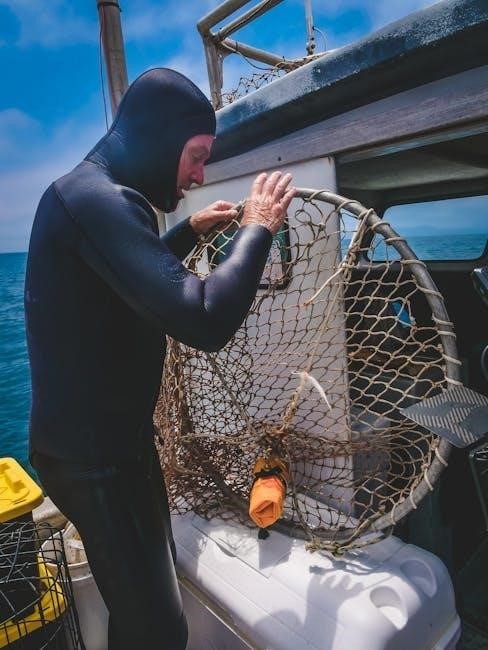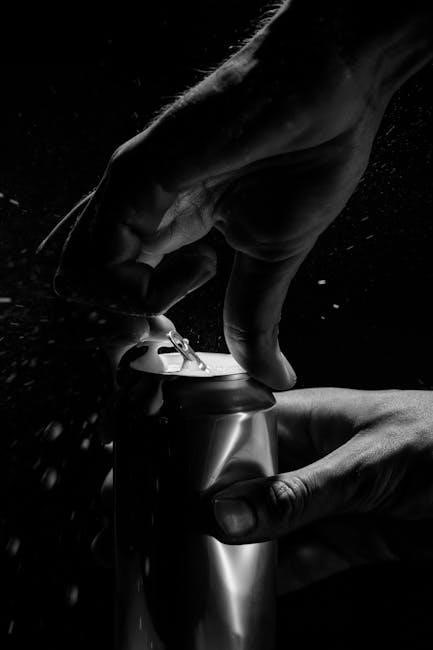Welcome to the PADI Open Water Diver Manual, your comprehensive guide to becoming a certified scuba diver. This manual provides detailed insights into safety, skills, and best practices for diving, ensuring a strong foundation for new divers.
1.1 Overview of the PADI Open Water Diver Certification
The PADI Open Water Diver certification is the world’s most popular entry-level scuba diving course. Designed for beginners, it teaches fundamental skills and knowledge needed to dive safely. PADI, the largest recreational diver training organization, offers this certification globally. The course covers basic scuba diving principles, safety procedures, and practical diving skills. Upon completion, divers are certified to explore underwater environments up to 18 meters. This certification is recognized worldwide and serves as a gateway to further diving adventures and advanced training. It emphasizes safety, environmental awareness, and responsible diving practices.
1.2 Importance of the PADI Open Water Diver Manual
The PADI Open Water Diver Manual is a vital resource for learners, providing detailed information on diving principles, safety protocols, and environmental awareness. It serves as the foundation for the Open Water Diver course, ensuring students gain a comprehensive understanding of scuba diving. The manual emphasizes safe diving practices, equipment usage, and responsible interactions with marine life. By following the guidelines outlined, divers can minimize risks and enjoy a safe, enjoyable experience. This manual is essential for both students and instructors, as it standardizes training and ensures consistency in teaching diving skills globally.

Structure of the PADI Open Water Diver Manual
The PADI Open Water Diver Manual is organized into clear chapters and sections, covering essential topics such as safety, diving skills, and environmental awareness. Each chapter builds progressively, ensuring a comprehensive understanding of scuba diving principles and practices. The manual is designed to be user-friendly, with detailed illustrations and easy-to-follow instructions, making it an invaluable guide for both students and instructors;
2.1 Chapters and Sections Overview
The PADI Open Water Diver Manual is divided into well-structured chapters, each focusing on specific aspects of scuba diving. The manual begins with an introduction to the certification process, followed by chapters on diving safety, equipment usage, and fundamental diving skills. Later sections cover dive planning, navigation, and environmental awareness. Each chapter is further divided into sections, providing in-depth information on topics such as dive physics, emergency procedures, and responsible diving practices. The manual concludes with resources for further learning and certification requirements, ensuring a comprehensive learning experience for aspiring divers.
2.2 Key Topics Covered in the Manual
The PADI Open Water Diver Manual covers essential topics to ensure a comprehensive understanding of scuba diving. It includes detailed sections on dive safety, equipment usage, and fundamental diving skills. The manual also emphasizes dive planning, navigation techniques, and environmental conservation. Key topics such as dive physics, Physiology, and emergency procedures are thoroughly explained. Additionally, the manual addresses responsible diving practices, marine life preservation, and the importance of pre-dive checks. These topics are presented in a logical sequence, building from basic concepts to advanced skills, ensuring divers are well-prepared for safe and enjoyable underwater experiences.

Safety Protocols and Guidelines
The PADI Open Water Diver Manual emphasizes safety through buddy checks, depth limits, and emergency procedures. It outlines proper equipment maintenance and pre-dive planning to ensure safe diving practices.
3.1 General Safety Procedures for Scuba Diving
Scuba diving safety begins with proper training and adherence to established protocols. The PADI Open Water Diver Manual outlines essential procedures, including buddy checks, depth limits, and air supply monitoring. Divers are taught to plan dives carefully, considering factors like water conditions, weather, and personal health. Pre-dive safety checks ensure equipment functionality, while post-dive procedures promote safe ascent practices. Understanding and following these guidelines minimizes risks, ensuring a safe and enjoyable diving experience. PADI emphasizes the importance of staying within certified limits and continuously monitoring the environment and buddy behavior during the dive.
3.2 Emergency Procedures and First Aid
The PADI Open Water Diver Manual details critical emergency procedures and first aid techniques to ensure diver safety. These include responding to panic situations, managing breathing difficulties, and executing rescues. Divers learn how to provide first aid for injuries such as cuts, sprains, and heat exhaustion. The manual also covers emergency signaling, underwater problem-solving, and proper ascent techniques to prevent decompression sickness. Understanding these procedures ensures divers can act calmly and effectively in critical situations, prioritizing safety and minimizing risks. PADI emphasizes preparedness and quick, decisive actions to protect both the diver and their buddy in emergencies.
Basic Scuba Diving Concepts
This section introduces fundamental principles of scuba diving, including buoyancy, breathing underwater, and pressure management. It lays the groundwork for understanding diving physiology and physics.
4.1 Understanding Dive Physics and Physiology
Understanding dive physics and physiology is essential for safe and enjoyable scuba diving. This section explains key concepts such as buoyancy, pressure, and gas laws. You’ll learn how water pressure affects the body and how to manage factors like equalization and gas absorption. Dive physics covers principles like Boyle’s Law and Dalton’s Law, which are critical for understanding how pressure changes impact air supply and diving depth. Physiology focuses on how the human body reacts to underwater conditions, including nitrogen absorption and decompression. Mastering these concepts ensures a solid foundation for safe diving practices and helps prevent common diving-related health issues. This knowledge is vital for every diver to enjoy underwater exploration responsibly and confidently.

4.2 Dive Planning and Navigation Basics
Dive planning and navigation are critical skills for every diver. This section teaches how to plan dives safely, considering factors like depth, time, and air supply. You’ll learn to use dive tables or computers to avoid exceeding safe limits and understand how to navigate underwater using compasses, landmarks, and natural navigation. Proper planning ensures you stay within safe boundaries and return to the surface safely; Navigation skills help you stay oriented and avoid getting lost. These basics are essential for building confidence and competence in diving, ensuring enjoyable and risk-free underwater experiences.

Equipment Overview
This section introduces the essential scuba diving gear, including masks, regulators, BCDs, and tanks. It explains their functions and the importance of proper use and maintenance.
5.1 Essential Scuba Diving Gear
The PADI Open Water Diver Manual details the fundamental equipment needed for safe and enjoyable diving. Essential gear includes a mask, snorkel, and fins for underwater vision and mobility. A buoyancy control device (BCD) helps divers maintain the correct depth, while a regulator delivers breathable air from the scuba tank; Wetsuits or dive skins protect against thermal exposure, and weight belts offset buoyancy. Each piece of equipment plays a critical role in ensuring safety, comfort, and diving efficiency. Understanding and properly using this gear is vital for every diver.
5.2 Proper Use and Maintenance of Equipment
Proper use and maintenance of scuba diving gear are crucial for safety and longevity. The PADI Open Water Diver Manual emphasizes regular inspections of equipment, such as checking for damage or wear on hoses, regulators, and BCDs. After each dive, gear should be rinsed with fresh water and stored in a cool, dry place to prevent corrosion and mold. Divers should avoid exposing equipment to harsh chemicals or extreme temperatures. Routine servicing by certified professionals is also essential to ensure optimal performance. Proper care extends the life of the gear and reduces the risk of equipment failure during dives.

Dive Planning and Execution
Dive planning ensures safe and enjoyable experiences. Proper execution involves following established safety guidelines, conducting pre-dive checks, and adhering to depth and time limits to minimize risks.
6.1 Pre-Dive Checks and Planning
Pre-dive checks and planning are critical for a safe and enjoyable diving experience. Start by assessing the dive site, weather, and water conditions. Ensure all equipment is functioning properly and fits correctly. Use a checklist to verify gear such as the regulator, BCD, and tank pressure. Plan the dive depth, time, and route based on your certification level and buddy’s preferences. Brief your buddy on hand signals, potential hazards, and the dive plan. Always dive within your limits and follow the buddy system for added safety. Proper planning helps prevent accidents and enhances the overall diving experience.
6.2 During the Dive: Best Practices
During the dive, maintain steady breathing to conserve air and stay relaxed. Monitor your air supply and depth regularly. Use hand signals to communicate clearly with your buddy. Stay within your depth and time limits to avoid exceeding safe boundaries. Avoid touching or disturbing marine life to preserve the ecosystem. If currents are strong, swim parallel to shore or use a reef as cover. Stay close to your buddy and ensure constant visual contact. Plan your ascent slowly, making a safety stop at 5 meters for 3 minutes to prevent decompression sickness. Always end the dive with at least 500 psi of air.

Marine Environment and Conservation
Understanding the marine environment is crucial for divers, as it fosters appreciation and promotes conservation. Human impact, such as pollution and overfishing, threatens marine ecosystems. Divers play a vital role in protecting marine life by adhering to responsible practices and supporting conservation efforts. By being mindful of their actions underwater, divers can help preserve the delicate balance of ocean ecosystems for future generations.
7.1 Understanding Marine Ecosystems
Marine ecosystems are complex communities of organisms interacting with their environment. Coral reefs, estuaries, and open waters support diverse life, from tiny plankton to large predators. These ecosystems rely on producers like algae and phytoplankton, which form the base of the food web. Consumers, including fish and invertebrates, play vital roles, while decomposers recycle nutrients. Understanding these interactions helps divers appreciate the delicate balance of marine life. Human activities, such as pollution and overfishing, can disrupt these systems, emphasizing the need for conservation efforts to protect biodiversity and maintain ecosystem health for future generations.
7.2 Responsible Diving Practices
Responsible diving practices are essential for preserving marine life and ecosystems. Divers should avoid touching or standing on coral reefs, as this can cause irreversible damage. Never feed or handle marine creatures, as it disrupts their natural behavior. Proper buoyancy control helps prevent stirring up sediment, which harms water clarity and marine life. Always carry a dive flag and follow local regulations, especially in protected areas. Avoid littering and take all trash with you. Respect marine life by not removing plants, coral, or animals. Dive within your certification level and plan dives to minimize environmental impact, ensuring sustainable diving for future generations.

Certification Process
The PADI Open Water Diver certification process involves completing knowledge development, confined water training, and open water dives, ensuring adherence to PADI standards for safety and proficiency.
8.1 Requirements for PADI Open Water Diver Certification
To qualify for the PADI Open Water Diver certification, candidates must meet specific requirements. These include completing all knowledge development sessions, confined water training, and open water dives. Candidates must also be at least 15 years old (or 10 years old for Junior Open Water Diver) and pass a medical examination. Additionally, students must demonstrate proficiency in water skills and pass the final exam. The certification process ensures that divers understand safety protocols, dive planning, and environmental awareness, preparing them for independent diving up to a maximum depth of 18 meters.
8.2 Final Exam and Skills Assessment
The final exam evaluates a candidate’s understanding of the PADI Open Water Diver Manual. It consists of multiple-choice questions covering topics like dive safety, physiology, and environmental considerations. Additionally, a skills assessment ensures practical competence. Candidates must demonstrate mastery of essential diving skills, such as equipment use, underwater navigation, and safety procedures. Successful completion of both the exam and skills assessment confirms readiness for certification. This comprehensive evaluation ensures divers are well-prepared to apply their knowledge and skills safely and confidently underwater.

Additional Resources and References
The PADI Open Water Diver Manual is supported by online resources, including videos, dive calculators, and guides. PADI also offers a digital logbook and apps for ongoing education. Supplementary materials like the PADI Adventures in Diving manual provide further learning opportunities, while the PADI website offers access to training tools, safety guidelines, and community forums. These resources help divers expand their knowledge and stay connected with the diving community for continuous improvement and skill development.
9.1 Supplementary Materials for Further Learning
Beyond the PADI Open Water Diver Manual, divers can access additional resources like the PADI Adventures in Diving manual for advanced techniques. The PADI Instructor’s guidance and online modules provide hands-on learning. Digital tools such as the PADI Training app and eRDPML calculator enhance understanding. Supplementary materials also include specialized guides for deep diving, wreck diving, and underwater photography. These resources ensure a comprehensive learning experience, helping divers refine their skills and explore new diving interests with confidence. The PADI website offers a wealth of information, making it easy to access these materials and continue growing as a diver.
9.2 Online Resources and PADI Support
The PADI Open Water Diver Manual is complemented by a variety of online resources available through the PADI website. The PADI Training app offers interactive content, videos, and quizzes to enhance learning. Additionally, PADI provides access to online courses, dive planning tools, and a community forum for connecting with instructors and fellow divers. The PADI website also features a dedicated section for learning materials, including downloadable guides and FAQs. These resources ensure continuous support for divers, helping them stay informed and engaged throughout their training and beyond.
Mastering the PADI Open Water Diver Manual prepares you for safe, enjoyable diving. Next steps include pursuing specialized courses and staying engaged with the diving community.
10.1 Continuing Education in Scuba Diving
After completing the PADI Open Water Diver certification, continuing education is crucial for enhancing skills and knowledge. Advanced courses like PADI Advanced Open Water Diver and specialized programs (e.g., Deep Diving, Wreck Diving, or Night Diving) offer deeper insights. These courses help divers gain confidence and explore new environments safely. Additionally, engaging with online resources and workshops provided by PADI ensures staying updated on best practices. Continuous learning fosters a safer, more enjoyable diving experience and opens doors to exciting underwater adventures. Divers are encouraged to pursue these opportunities to grow as skilled and responsible divers.

10.2 Staying Engaged with the Diving Community
Staying engaged with the diving community enhances your diving journey and fosters lifelong connections. Joining local diving clubs, participating in group dives, and attending workshops can broaden your network and knowledge. Online forums and social media groups dedicated to scuba diving provide platforms to share experiences and gain insights. PADI also offers events and activities that promote community involvement. Engaging with fellow divers and instructors helps you stay motivated, learn new techniques, and explore diverse diving opportunities. Active participation in the diving community not only enriches your personal growth but also contributes to marine conservation efforts and responsible diving practices.

